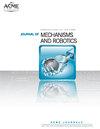Design and Implementation of Upper-Body Exoskeleton for Assistance of Individuals With Manual Handling Tasks
IF 3.2
4区 计算机科学
Q2 ENGINEERING, MECHANICAL
Journal of Mechanisms and Robotics-Transactions of the Asme
Pub Date : 2023-10-16
DOI:10.1115/1.4063455
引用次数: 0
Abstract
Abstract This paper illustrates the design and testing of an upper-body exoskeleton for the assistance of individuals with load-lifting and load-carrying tasks, and the provided assistive force can well match with the force required by the human. First, the biomechanics of the human lumbar during the squat lifting of an object is described. Next, the modeling of the exoskeleton is introduced. Additionally, the hardware design of the exoskeleton is presented. The exoskeleton is mainly composed of a back-assist mechanism and an upper extremity labor-saving mechanism, which can assist the wearer’s lumbar during the squat lifting of an object and assist the wearer’s arms to carry an object during walking, respectively. Finally, experiments are conducted to evaluate the performance of the developed upper-body exoskeleton. The experimental results demonstrate that the exoskeleton has the potential to provide assistance for individuals with manual handling tasks. An average assistive force of 44.8 N can be provided for the wearer to lift a 10-kg object. During the squat lifting of the 10-kg object, reductions of 31.86% and 28.30% of the average muscle activities of the wearer’s lumbar erector spinae and thoracic erector spinae are observed, respectively. In addition, a reduction of 23.78% of the average muscle activity of the wearer’s biceps brachii is observed during walking while carrying the 10-kg object.上肢外骨骼的设计与实现,以协助个人的体力处理任务
摘要:本文设计并测试了一种用于辅助个人进行起重和搬运任务的上肢外骨骼,所提供的辅助力与人体所需的力匹配良好。首先,描述了深蹲举起物体时人体腰椎的生物力学。其次,介绍了外骨骼的建模。此外,还介绍了外骨骼的硬件设计。外骨骼主要由背部辅助机构和上肢省力机构组成,分别可以在深蹲抬起物体时辅助佩戴者的腰部,在行走时辅助佩戴者的手臂搬运物体。最后,通过实验对所研制的上肢外骨骼进行了性能评价。实验结果表明,该外骨骼具有为个人手动处理任务提供帮助的潜力。佩戴者举起10公斤重的物体时,可提供平均44.8牛的辅助力。在深蹲举10公斤物体时,观察到佩戴者腰竖脊肌和胸竖脊肌的平均肌肉活动分别减少31.86%和28.30%。此外,在携带10公斤的物体行走时,佩戴者肱二头肌的平均肌肉活动减少了23.78%。
本文章由计算机程序翻译,如有差异,请以英文原文为准。
求助全文
约1分钟内获得全文
求助全文
来源期刊

Journal of Mechanisms and Robotics-Transactions of the Asme
ENGINEERING, MECHANICAL-ROBOTICS
CiteScore
5.60
自引率
15.40%
发文量
131
审稿时长
4.5 months
期刊介绍:
Fundamental theory, algorithms, design, manufacture, and experimental validation for mechanisms and robots; Theoretical and applied kinematics; Mechanism synthesis and design; Analysis and design of robot manipulators, hands and legs, soft robotics, compliant mechanisms, origami and folded robots, printed robots, and haptic devices; Novel fabrication; Actuation and control techniques for mechanisms and robotics; Bio-inspired approaches to mechanism and robot design; Mechanics and design of micro- and nano-scale devices.
 求助内容:
求助内容: 应助结果提醒方式:
应助结果提醒方式:


